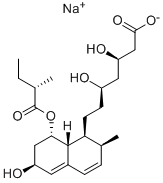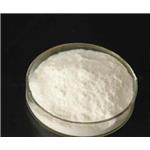Definition
ChEBI: Pravastatin is a carboxylic ester resulting from the formal condensation of (S)-2-methylbutyric acid with the hydroxy group adjacent to the ring junction of (3R,5R)-7-[(1S,2S,6S,8S,8aR)-6,8-dihydroxy-2-methyl-1,2,6,7,8,8a-hexahydronaphthalen-1-yl]-3,5-dihydroxyheptanoic acid. Derived from microbial transformation of mevastatin, pravastatin is a reversible inhibitor of 3-hydroxy-3-methylglutaryl-coenzyme A (HMG-CoA). The sodium salt is used for lowering cholesterol and preventing cardiovascular disease. It is one of the lower potency statins, but has the advantage of fewer side effects compared with lovastatin and simvastatin. It has a role as a metabolite, an anticholesteremic drug, a xenobiotic and an environmental contaminant. It is a 3-hydroxy carboxylic acid, a hydroxy monocarboxylic acid, a carboxylic ester, a secondary alcohol, a carbobicyclic compound and a statin (semi-synthetic). It is functionally related to a (3R,5R)-7-[(1S,2S,6S,8S,8aR)-6,8-dihydroxy-2-methyl-1,2,6,7,8,8a-hexahydronaphthalen-1-yl]-3,5-dihydroxyheptanoic acid and a (S)-2-methylbutyric acid. It is a conjugate acid of a pravastatin(1-).
Manufacturing Process
Pravastatin was isolated as products of enzymatic hydroxylation by some kinds of microorganisms of [1S-[1-α(R*),7β,8β(2S*,4S*)8αβ]]-2methylbutanoic acid 1,2,3,7,8,8a-hexahydro-7-methyl-8-[2-(tetrahydro-4hydroxy-6-oxo-2))-pyran-2-yl)ethyl]-1-naphthalenic lactone (campactin) or their carboxylic acid or their salts (products of animal metabolism of microorganisms from the genera Nocardia, Streptomyces et cetera).
Pravastatin may be preparated by using the microorganisms of genera Nocardia (method 1) and Mortierella (method 2).
Method 1
Cultivation of Nocardia autotrophica subsp. amethystineCells of Nocardia autotrophica subsp. amethystina FERM P-6183 was inoculated from a slant culture by means of a platinum loop into each of twenty 500 ml Erlenmeyer flasks, each containing 100 ml of a culture medium having the following composition: glucose - 1.0%, peptone - 0.2%, meat extract - 0.1%, yeast extract - 0.1%, corn steep liquor 0.3%, tap water balance..
Shaking was then carried out at 26°C and 220 r.p.m. for 2 days, at which time sodium 2-methyl-8-(2-methyl-1-oxobutoxy)-β,δ-dihydroxy(1S-(1-α(βS*,δ-S*),2-α,6-α,8-β(R*),8a-α))-1-1,2,6,7,8,8ahexahydronaphthaleneheptanoate was added to a final concentration of 0.05% w/v. Incubation was continued at 26°C and 220 r.p.m. for a further 5 days.
Preparation of pravastatin
After completion of the cultivation, the reaction mixture was filtered and the pH of the filtrate was adjusted to a value of 3 by the addition of trifluoroacetic acid. The acidified filtrate was then extracted three times, each with 1 liter of ethyl acetate, to give extracts containing a mixture (6-α and 6-β) of (1S-(1α,β- S*,δ-S*),2-α,8-βR*),8a-α))-1-naphthaleneheptanoic acid 1,2,6,7,8,8ahexahydro-2-methyl-8-(2-methyl-1-oxobutoxy)-β,δ,6-trihydroxy.
This extract was then immediately transferred into a 5% w/v aqueous solution of sodium hydrogen carbonate, and the pH of the mixture was adjusted to a value of 7.0 by the addition of 2 N hydrochloric acid. The mixture was then adsorbed on a Diaion HP-20 column. The column was washed with water and then eluted with 50% v/v aqueous acetone to give a fraction containing (1S(1-α,β- S*,δ-S*),2-α,6-α,8-βR*),8a-α))-1-naphthaleneheptanoic acid 1,2,6,7,8,8a-hexahydro-2-methyl-8-(2-methyl-1-oxobutoxy)-β,δ,6-trihydroxy-, monosodium salt (pravastatin). This was freeze-dried, to give 200 mg of pravastatine.
Method 2
Cultivation of Mortierella maculata nov. spec. E-97 [NCAIM(P)F 001266]
A spore suspension was prepared with 5 ml of a 0.9% sodium chloride solution obtained from a 7-10 day old, malt extract-yeast extract agar slant culture of Mortierella maculata nov. spec. E-97 [NCAIM(P)F 001266] strain able to 6-β-hydroxylate compactin and the suspension was used to inoculate 100 ml inoculum medium PI (glucose-50 g, soybean meal-20 g, in 1000 ml tap water) sterilized in a 500 ml Erlenmeyer flask.
5 liters working volume a bioconversion culture medium is prepared (glucose20 g, glycerine-20 g, soybean meal-20 g, peptone-5 g, potassium dihydrogen phosphate-0.5 g, polypropylene glycol 2000-1 g, in 1000 ml tap water); the components of the culture medium are added corresponding to 5 liters. Then it was sterilized for 45 min at 121°C and seeded with 500 ml of the inoculum culture.
Before sterilization the pH of the medium was adjusted to 7.0 value.
The fermentation was carried out at 28°C, with a stirring rate of 400 rpm andwith an aeration rate from bottom direction 60 liters/hour for 4 days. At the 2nd day after the transfer the culture started to foam heavily, which can be decreased by the addition of further polypropylene glycol 2000. The pH reached 6.3-7.5 by the 4th day. The feeding of the sodium 2-methyl-8-(2methyl-1-oxobutoxy)-β,δ-dihydroxy(1S-(1-α(β- S*,δ-S*),2-α,6-α,8-β(R*),8aα))-1-1,2,6,7,8,8a-hexahydronaphthaleneheptanoate substrate is allowed to be started if the pH of the broth is above 6.3.
Preparation of pravastatinAt the 4th day of the fermentation 2.5 g compactin substrate is added in sterile filtered aqueous solution. Calculated for the volume of the broth 0.51.0% glucose was added into the culture depending on the pH in the form of 50% solution sterilized at 121°C for 25 min in parallel with the substrate feeding. After 24 hours the compactin substrate is consumed from the culture (is detected by HPLC) and was converted to pravastatin. By lyophilization of the aqueous residue 1.3 g pravastatin was obtained. The chromatographically pure product was crystallized from a mixture of ethanol and ethyl acetate. Melting point: 170-173°C (decomp.).





